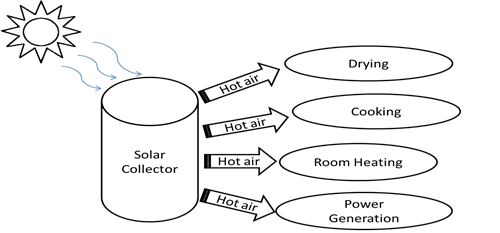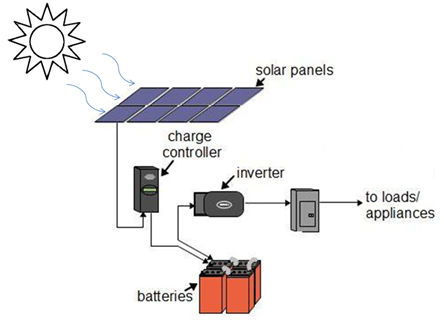Authors: Th. Bidyalakshmi Devi1, Yogesh B Kalnar2, Sandeep P Dawange 3 and K. Bembem2
1Agricultural Structure and Environmental Control Division, ICAR-CIPHET, Ludhiana
2 Transfer of Technology Division, ICAR-CIPHET, Ludhiana
3Food Grain and Oilseed Processing Division, ICAR-CIPHET, Ludhiana
Proper management of energy is one of the main criteria for sustainable development in agriculture. Limited resources of fossil fuels and its negative impact on environment results in more focus on renewable energy. Renewable energy sources include energy from water, sun, wind, tidal, geothermal and biomass. Among these renewable energy sources, all are region based except sun and biomass. The total amount of energy received on the earth’s surface is just a fraction of total radiation of the sun. About 5,000 trillion kWh per year energy is incident over India's land with an average value of 4-7 kWh per sq. m per day (https://mnre.gov.in/solar). The fraction of radiation includes visible light, infrared, ultraviolet and other traces of radiations. Both the electrical and thermal energy can achieve from solar energy through proper collectors. Direct electricity can be generated using solar photovoltaic panels whereas thermal energy can be achieved using solar thermal collectors. Solar thermal collectors may be flat plate collector, concentrated thermal collector or evacuated tube collector. The focus of solar energy in agriculture sectors has been increasing as it is readily available and pollution free. The only important is to design a reliable mechanisms for harnessing the solar energy so that it could be available during unclear weather conditions. India Government is also focusing more on renewable energy for sustainable development.
Solar energy can be utilized in different sectors of agriculture. Thermal energy can harness for utilization in drying, cooling, steam generation etc. whereas electrical energy can be used in pumping water for irrigation, rural electrification and to operate various agricultural machineries.
Solar thermal energy in agricultural operations
Solar thermal energy can be obtained using solar collectors. The thermal energy is commonly used for heating either water or air. The solar thermal collectors may be of flat plate collector, concentrated collector, Evacuated tube collector (ETC), concentrated tube collector (CTC) etc. The thermal energy can be stored either in the form of sensible heat or latent heat. Most commonly used sensible heat storage medium are pebbles, rock, steel, water, oil, sand etc. whereas latent heat are stored in organic (paraffin wax) and inorganic (acid, chemical salt) medium. Figure (1) shows various application of solar thermal energy.

Fig.1. Application of Solar thermal energy in various operations
- Drying
- Cooking
- Greenhouse heating
- Cooling
Solar electrical energy in agricultural operations
Solar power photovoltaic panels convert sun’s ray into electricity. Free electrons are generated when the radiation falls into the solar cell made of silicon. Thus, electricity can be produced. The electricity can be stored in solar storage battery and used when there is no or less radiation. Figure (2) shows the flowchart and appliances required for harnessing electrical energy from solar energy.

Fig.2. Application of solar energy as electric source
- Rural electrification The electrification at village level in the country is poor. Moreover, it is diminutive and irregular. Electricity generated by solar can be used for individual home or as community based system. This will provide an energy source for different agricultural operations at village levels. Moreover, it provides convenience and reduce drudgery of the farmers while working.
- Energy for agricultural operations The power required for different agricultural operations at farm level such as farm fencing, threshing, drying, milling, water pumping for irrigation, desalination etc. can be achieved from solar electrical power. Government of India is also focusing more on renewable energy in every sectors. It is expected to spend over $21 million to implement solar power equipment and solar power projects in agricultural sectors (https://cleantechnica.com/2018/02/27/india-plans-21-million-solar-power-program-agricultural-sector/). Moreover, many schemes have been developed under Ministry of New and Renewable Energy and provides subsidies to the farmers. Under Jawaharlal Nehru National Solar Mission, 90% subsidy is provided for solar lighting system to cover about 10,000 villages under village electrification program of Ministry of New and Renewable Energy (MNRE), (https://mnre.gov.in/sites/default/files/uploads/mission_document_JNNSM.pdf). Also, a new scheme to support 30,000 solar pumping units per year, MNRE-GoI has launched a scheme with the aim of replacing diesel pump sets with solar pump sets. It enables the farmers for more production and generate income as it has low operating cost and provide uninterrupted power supply. (https://www.nabard.org/content1.aspx?id=596&catid=23&mid=).
References:
1. https://mnre.gov.in/solar
2. https://cleantechnica.com/2018/02/27/india-plans-21-million-solar-power-program-agricultural-sector/
3. https://mnre.gov.in/sites/default/files/uploads/mission_document_JNNSM.pdf
4. https://www.nabard.org/content1.aspx?id=596&catid=23&mid=
About Author / Additional Info: